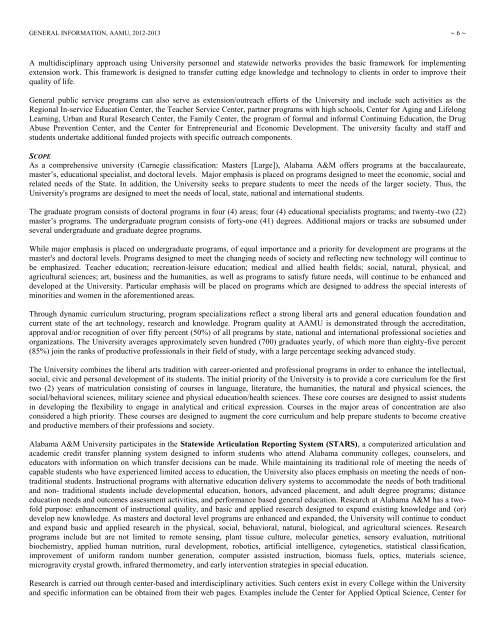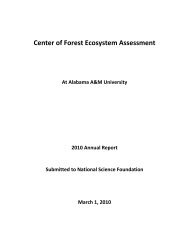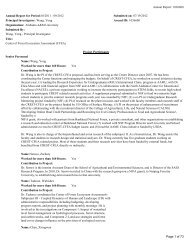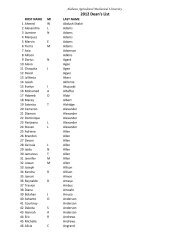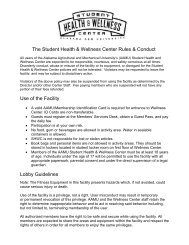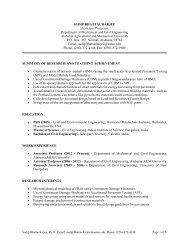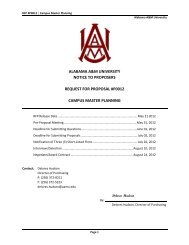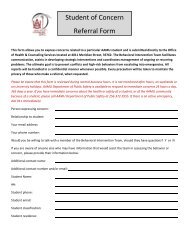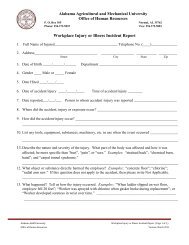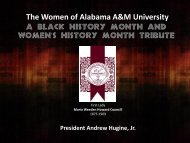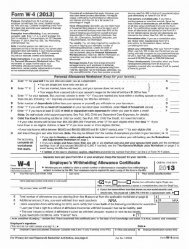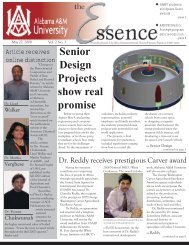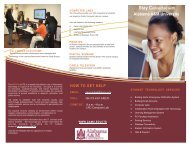Undergraduate Bulletin 2012-2013 - Alabama A&M University
Undergraduate Bulletin 2012-2013 - Alabama A&M University
Undergraduate Bulletin 2012-2013 - Alabama A&M University
Create successful ePaper yourself
Turn your PDF publications into a flip-book with our unique Google optimized e-Paper software.
GENERAL INFORMATION, AAMU, <strong>2012</strong>-<strong>2013</strong> ~ 6 ~<br />
A multidisciplinary approach using <strong>University</strong> personnel and statewide networks provides the basic framework for implementing<br />
extension work. This framework is designed to transfer cutting edge knowledge and technology to clients in order to improve their<br />
quality of life.<br />
General public service programs can also serve as extension/outreach efforts of the <strong>University</strong> and include such activities as the<br />
Regional In-service Education Center, the Teacher Service Center, partner programs with high schools, Center for Aging and Lifelong<br />
Learning, Urban and Rural Research Center, the Family Center, the program of formal and informal Continuing Education, the Drug<br />
Abuse Prevention Center, and the Center for Entrepreneurial and Economic Development. The university faculty and staff and<br />
students undertake additional funded projects with specific outreach components.<br />
SCOPE<br />
As a comprehensive university (Carnegie classification: Masters [Large]), <strong>Alabama</strong> A&M offers programs at the baccalaureate,<br />
master’s, educational specialist, and doctoral levels. Major emphasis is placed on programs designed to meet the economic, social and<br />
related needs of the State. In addition, the <strong>University</strong> seeks to prepare students to meet the needs of the larger society. Thus, the<br />
<strong>University</strong>'s programs are designed to meet the needs of local, state, national and international students.<br />
The graduate program consists of doctoral programs in four (4) areas; four (4) educational specialists programs; and twenty-two (22)<br />
master’s programs. The undergraduate program consists of forty-one (41) degrees. Additional majors or tracks are subsumed under<br />
several undergraduate and graduate degree programs.<br />
While major emphasis is placed on undergraduate programs, of equal importance and a priority for development are programs at the<br />
master's and doctoral levels. Programs designed to meet the changing needs of society and reflecting new technology will continue to<br />
be emphasized. Teacher education; recreation-leisure education; medical and allied health fields; social, natural, physical, and<br />
agricultural sciences; art, business and the humanities, as well as programs to satisfy future needs, will continue to be enhanced and<br />
developed at the <strong>University</strong>. Particular emphasis will be placed on programs which are designed to address the special interests of<br />
minorities and women in the aforementioned areas.<br />
Through dynamic curriculum structuring, program specializations reflect a strong liberal arts and general education foundation and<br />
current state of the art technology, research and knowledge. Program quality at AAMU is demonstrated through the accreditation,<br />
approval and/or recognition of over fifty percent (50%) of all programs by state, national and international professional societies and<br />
organizations. The <strong>University</strong> averages approximately seven hundred (700) graduates yearly, of which more than eighty-five percent<br />
(85%) join the ranks of productive professionals in their field of study, with a large percentage seeking advanced study.<br />
The <strong>University</strong> combines the liberal arts tradition with career-oriented and professional programs in order to enhance the intellectual,<br />
social, civic and personal development of its students. The initial priority of the <strong>University</strong> is to provide a core curriculum for the first<br />
two (2) years of matriculation consisting of courses in language, literature, the humanities, the natural and physical sciences, the<br />
social/behavioral sciences, military science and physical education/health sciences. These core courses are designed to assist students<br />
in developing the flexibility to engage in analytical and critical expression. Courses in the major areas of concentration are also<br />
considered a high priority. These courses are designed to augment the core curriculum and help prepare students to become creative<br />
and productive members of their professions and society.<br />
<strong>Alabama</strong> A&M <strong>University</strong> participates in the Statewide Articulation Reporting System (STARS), a computerized articulation and<br />
academic credit transfer planning system designed to inform students who attend <strong>Alabama</strong> community colleges, counselors, and<br />
educators with information on which transfer decisions can be made. While maintaining its traditional role of meeting the needs of<br />
capable students who have experienced limited access to education, the <strong>University</strong> also places emphasis on meeting the needs of nontraditional<br />
students. Instructional programs with alternative education delivery systems to accommodate the needs of both traditional<br />
and non- traditional students include developmental education, honors, advanced placement, and adult degree programs; distance<br />
education needs and outcomes assessment activities, and performance based general education. Research at <strong>Alabama</strong> A&M has a twofold<br />
purpose: enhancement of instructional quality, and basic and applied research designed to expand existing knowledge and (or)<br />
develop new knowledge. As masters and doctoral level programs are enhanced and expanded, the <strong>University</strong> will continue to conduct<br />
and expand basic and applied research in the physical, social, behavioral, natural, biological, and agricultural sciences. Research<br />
programs include but are not limited to remote sensing, plant tissue culture, molecular genetics, sensory evaluation, nutritional<br />
biochemistry, applied human nutrition, rural development, robotics, artificial intelligence, cytogenetics, statistical classification,<br />
improvement of uniform random number generation, computer assisted instruction, biomass fuels, optics, materials science,<br />
microgravity crystal growth, infrared thermometry, and early intervention strategies in special education.<br />
Research is carried out through center-based and interdisciplinary activities. Such centers exist in every College within the <strong>University</strong><br />
and specific information can be obtained from their web pages. Examples include the Center for Applied Optical Science, Center for


